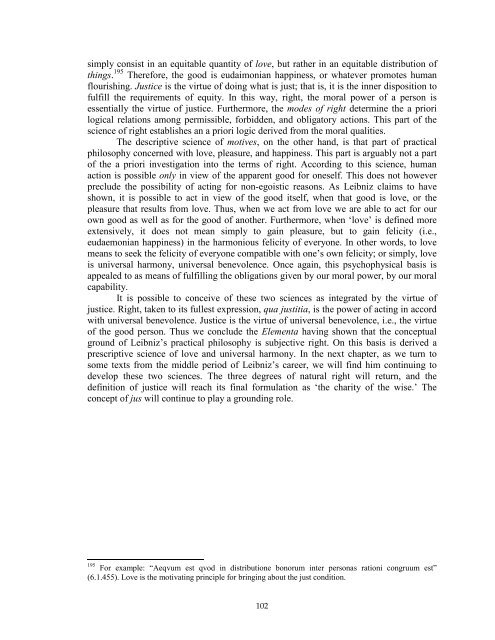Stony Brook University
Stony Brook University
Stony Brook University
Create successful ePaper yourself
Turn your PDF publications into a flip-book with our unique Google optimized e-Paper software.
simply consist in an equitable quantity of love, but rather in an equitable distribution of<br />
things. 195 Therefore, the good is eudaimonian happiness, or whatever promotes human<br />
flourishing. Justice is the virtue of doing what is just; that is, it is the inner disposition to<br />
fulfill the requirements of equity. In this way, right, the moral power of a person is<br />
essentially the virtue of justice. Furthermore, the modes of right determine the a priori<br />
logical relations among permissible, forbidden, and obligatory actions. This part of the<br />
science of right establishes an a priori logic derived from the moral qualities.<br />
The descriptive science of motives, on the other hand, is that part of practical<br />
philosophy concerned with love, pleasure, and happiness. This part is arguably not a part<br />
of the a priori investigation into the terms of right. According to this science, human<br />
action is possible only in view of the apparent good for oneself. This does not however<br />
preclude the possibility of acting for non-egoistic reasons. As Leibniz claims to have<br />
shown, it is possible to act in view of the good itself, when that good is love, or the<br />
pleasure that results from love. Thus, when we act from love we are able to act for our<br />
own good as well as for the good of another. Furthermore, when ‘love’ is defined more<br />
extensively, it does not mean simply to gain pleasure, but to gain felicity (i.e.,<br />
eudaemonian happiness) in the harmonious felicity of everyone. In other words, to love<br />
means to seek the felicity of everyone compatible with one’s own felicity; or simply, love<br />
is universal harmony, universal benevolence. Once again, this psychophysical basis is<br />
appealed to as means of fulfilling the obligations given by our moral power, by our moral<br />
capability.<br />
It is possible to conceive of these two sciences as integrated by the virtue of<br />
justice. Right, taken to its fullest expression, qua justitia, is the power of acting in accord<br />
with universal benevolence. Justice is the virtue of universal benevolence, i.e., the virtue<br />
of the good person. Thus we conclude the Elementa having shown that the conceptual<br />
ground of Leibniz’s practical philosophy is subjective right. On this basis is derived a<br />
prescriptive science of love and universal harmony. In the next chapter, as we turn to<br />
some texts from the middle period of Leibniz’s career, we will find him continuing to<br />
develop these two sciences. The three degrees of natural right will return, and the<br />
definition of justice will reach its final formulation as ‘the charity of the wise.’ The<br />
concept of jus will continue to play a grounding role.<br />
195 For example: “Aeqvum est qvod in distributione bonorum inter personas rationi congruum est”<br />
(6.1.455). Love is the motivating principle for bringing about the just condition.<br />
102
















